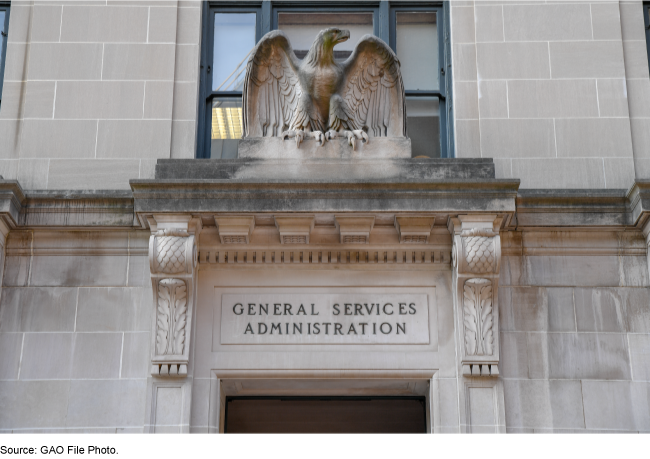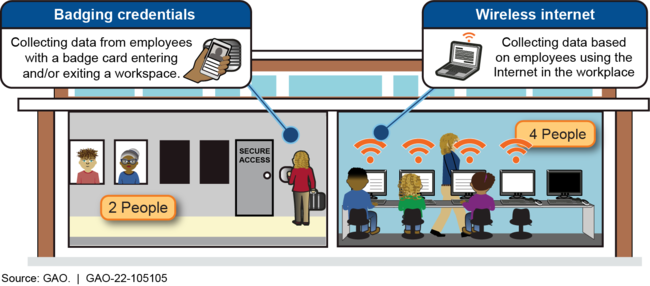Federal Real Property: GSA Could Further Support Agencies' Post-Pandemic Planning for Office Space Use
Fast Facts
Most federal employees worked remotely during the COVID-19 pandemic, leaving many federal facilities underutilized.
The pandemic significantly altered the government's office space needs and has it reconsidering the size and scale of its real property portfolio. The General Services Administration sees this as an opportunity to restructure that portfolio and is taking steps to make cost-effective decisions by collecting data on how often employees report to federal offices and what parts of the office they use.
GSA doesn't plan to broadly share this data, but we recommended doing so to help agencies plan future office space use.

Highlights
What GAO Found
Federal agencies reported making limited initial changes to leased and owned office space due to the pandemic, but many reported plans to reduce space going forward. Specifically, from March 2020 to March 2022, 17 of 24 major federal agencies GAO surveyed reported the pandemic resulted in limited reductions to office space due, in part, to the uncertainty on how employees will work in the future. However, in the next 3 years, most agencies reported that they expect to reduce the number of leases or square footage in their real estate portfolio, primarily in response to increases in telework.
The General Services Administration (GSA) has taken some steps to support federal office space-planning in the post-pandemic environment. In response to the pandemic, the GSA has supported federal agencies by expanding ongoing office space-planning services and collecting new data. These data collection efforts include:
- pilot-testing technologies for collecting space utilization data—the number of employees in buildings on a daily or hourly basis (see figure below), and
- collecting additional space utilization data at GSA-leased and federally owned properties.
However, GSA has no plans to widely share information that it is gathering in pilot programs and data collection efforts, and that sharing could help agencies better understand their future space needs.
While many agencies—13 of the 24 GAO surveyed—agreed that such data could be helpful in their planning, all 24 agencies expressed concerns, including about the costs to collect data. Consequently, most of these agencies (20 of 24) reported collecting limited or no space utilization data. GSA officials stated they have no plans to distribute information on the costs and benefits of space utilization data learned from their efforts beyond agencies that use GSA space-planning services. By not planning to more broadly share this information, GSA is missing an opportunity to provide a clear understanding of how the potential costs of collecting such data could be outweighed by the long-term benefits, including potential cost savings from reductions in future annual rent, maintenance, and other operational costs.
Selected Types of Technologies That Can Provide Space Utilization Data

Why GAO Did This Study
When the COVID-19 national emergency was announced in March 2020, federal agencies adopted a maximum telework posture, leaving many federal facilities (both leased and owned) underutilized. While future space needs are uncertain, many, including GSA, expect federal agencies will require less office space.
The CARES Act includes a provision for GAO to report on the federal response to the pandemic. GAO was also asked to report on federal agencies' real property plans during and after the COVID-19 pandemic. This report discusses changes agencies made to office space in response to the COVID-19 pandemic and anticipated changes to be made in the next 3 years, and assesses how GSA has supported post-pandemic federal office space-planning.
GAO surveyed the 24 Chief Financial Officers Act agencies about the effects of COVID-19 on current and future plans for office space, and space utilization data. GAO also reviewed relevant statutes, guidance, and GSA's leasing inventory data, and interviewed agency officials.
Recommendations
GAO recommends that GSA develop a plan to broadly share with federal agencies, including those that do not use GSA services, information learned from GSA's pilots and other space utilization data collection efforts. GSA agreed with the recommendation and stated it will communicate lessons learned from pilots and other data collection activities.
Recommendations for Executive Action
| Agency Affected | Recommendation | Status |
|---|---|---|
| General Services Administration |
Priority Rec.
The Administrator of the GSA should develop a plan to broadly share with federal agencies, including those that do not use GSA services, information learned from GSA's pilots and other space utilization data collection efforts. (Recommendation 1). |
In 2025, in response to the Thomas R. Carper Water Resource Development Act of 2024, GSA published on its website a list of technologies for collecting space utilization data and the contractors that can provide them. This list includes pre-approved vendors and directs agencies to GSA Advantage - a website that includes pricing and purchasing information. By taking these actions, GSA has shared with the agencies the information they need on technologies for collecting space utilization data, which meets the intent of GAO's recommendation. GSA's actions will also enable the agencies to make informed investments in data collection technologies that will help them identify excess office space that is no longer needed, which could ultimately reduce the federal real property footprint and produce cost savings.
|
